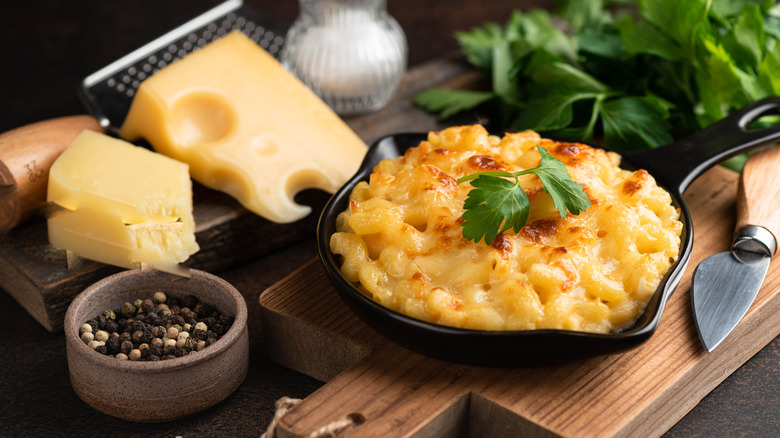Grainy Mac And Cheese? Try Rachael Ray's Foolproof Tip
While it's always a good idea to keep boxed mac and cheese stocked in the pantry, there are times when making it from scratch is worth the extra effort. No boxed version can replicate the rich, creamy flavor of a homemade cheese sauce. But if your sauce turns out thick, grainy, or clumpy, the issue likely lies in your ratios and cooking technique. In a "Q Ray and J" YouTube segment, chef Rachael Ray breaks down the keys to a smooth, velvety sauce — and it starts with the roux. Ray recommends a ratio of four parts flour to five parts of butter, followed by three cups of warmed milk (or a mixture of milk and stock). She says to allow the roux to thicken enough to coat the back of a spoon, but no thicker, as too thick a base can lead to a gritty texture.
As for the cheese, Ray advises equal parts cheese and milk, which in her case is three cups of loosely packed shredded cheese. When you're ready to add the cheese, avoid over-stirring — it's a mistake that ruins mac and cheese's texture. According to Ray, the secret is to remove your sauce from the heat as soon as the cheese melts in. High heat can cause the fat and proteins to separate, turning your creamy dream into a curdled mess.
How to nail your mac and cheese texture every time
Despite its simplicity, homemade mac and cheese takes a bit more finesse than it lets on. Ideally, you want to end up with the perfect blend of silky smooth sauce, soft noodles, and a crunchy top, baked to golden perfection. If you've already nailed your cheese-to-liquid ratio and you remembered to take the sauce off the heat after adding cheese like Rachael Ray, you're off to a strong start. However, texture perfection lies in the details.
Let's start with the mac. Boiling pasta may seem foolproof, but it's crucial to cook it al dente — or even a minute or two shy. Since the pasta will continue cooking in the hot sauce (and again if baked), undercooking slightly ensures it stays tender and not mushy. Choosing the right type of noodle for mac and cheese also matters: short, sturdy pastas like elbows or shells can hold sauce without falling apart.
When it comes to the cheese, choose one that melts easily and brings balanced flavor, such as a sharp cheddar, Gouda, or Gruyère. Don't forget to grate your cheese fresh off the block since pre-shredded varieties contain anti-caking agents that can interfere with melting.
Finally, if you really want to prioritize texture, a creamy mac and cheese goes great with a crunchy topping, such as bread crumbs, crackers, or salty bacon. For maximum crunch, broil the mac and cheese for a few minutes just before serving, until the top is bubbling and golden brown.


